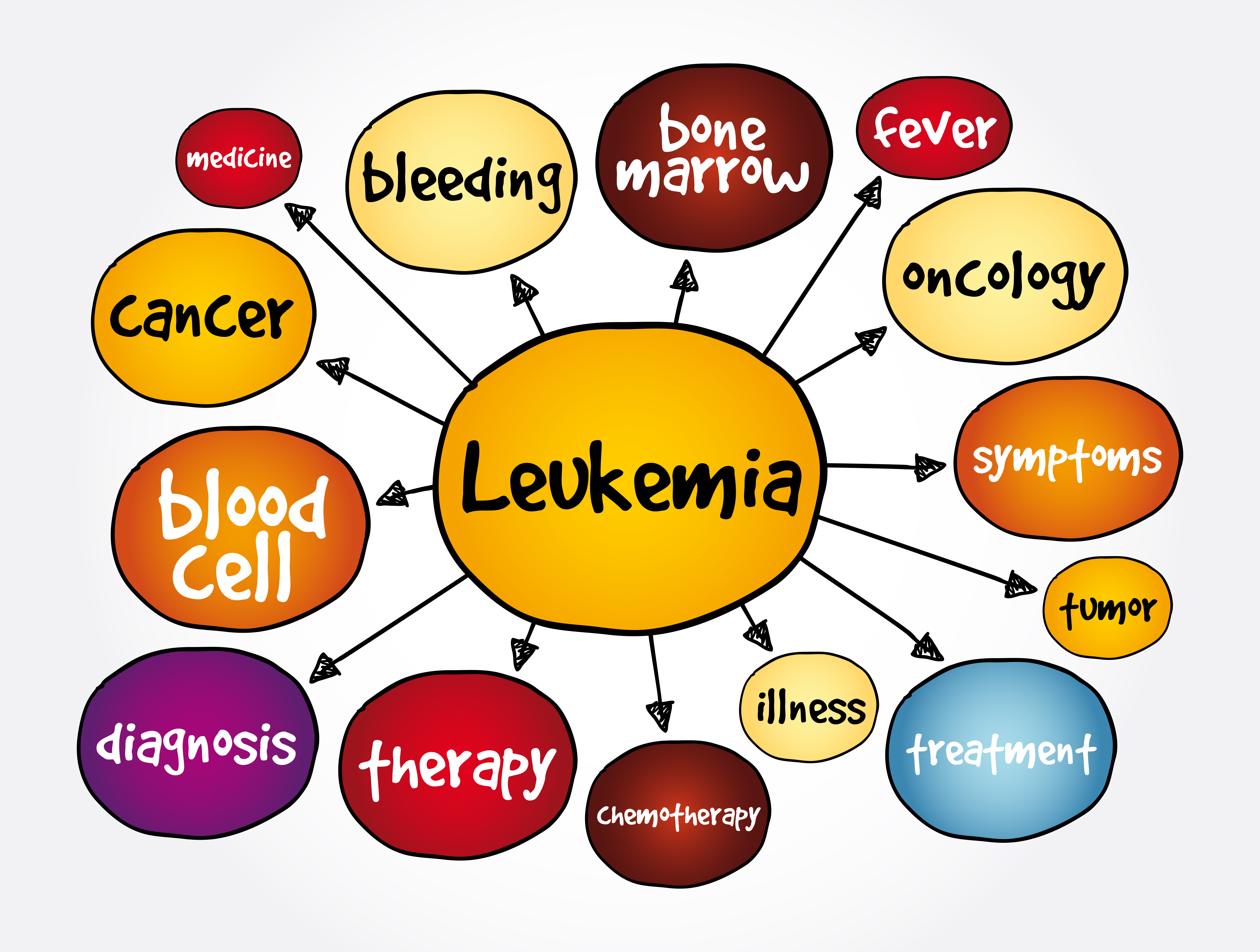ACUTE LEUKEMIA & DISABILITY BENEFITS
WHAT IS LEUKEMIA?
Acute Leukemia is a form of cancer that starts in the bone marrow, where your blood cells are produced. It affects white blood cells, which are crucial for the body’s immune system. Acute leukemia starts when a cell changes and becomes a leukemia cell. Because it no longer matures the way it should, it grows out of control. Often, it divides to make new cells faster than normal.
Leukemia cells also don’t die when they should. This allows them to build up in the bone marrow, crowding out normal cells. Then, the cancer causes large numbers of immature white blood cells to enter the blood stream. The cells can travel to your organs. Once inside the organ, the leukemia cells make it so the organ doesn’t work properly.
Because it is a cancer that often results in death, acute leukemia is on SSA’s special allowances list. Learn more information about compassionate allowances.
DIFFERENCES BETWEEN TYPES OF LEUKEMIA
If the growth of the white blood cells involves the lymphoid line, then your disease is acute lymphocytic leukemia. Similarly, if the growth of the white blood cells involves the myeloid line, then you have acute myeloid leukemia. Acute lymphocytic leukemia is also known as acute lymphoblastic leukemia.
Acute lymphocytic leukemia is the most common type of cancer in children. If you have this cancer as a child, then there is good chance for a cure. Acute lymphocytic leukemia can also occur in adults. However, if you are an adult with the disease, the chance of a cure is far less.
DIAGNOSTIC TESTING FOR ACUTE LEUKEMIA
Your doctor finds acute leukemia is made by physical exam and history. Your doctor will then perform a complete blood count. Also, your doctor may perform specific tests. These include a blood smear and bone marrow biopsy. Your doctor may also do an imaging test or a spinal fluid test. In the case of acute leukemia, bone marrow testing will tell you if you have the disease.
POSSIBLE TESTS FOR LEUKEMIA
- Blood tests. Blood tests may reveal too many or too few white blood cells. Likewise, a blood test may show not enough red blood cells and not enough platelets. A blood test can also show the presence of blast cells. These are the immature cells normally found in the bone marrow.
- Bone marrow test. During bone marrow biopsy, the doctor uses a needle to remove a sample of your bone marrow. The sample comes from your hipbone or breastbone. Next, the bone marrow sample is sent to a lab for testing to look for cancer cells. Doctors in the lab will group blood cells into specific types based on their size, shape, and other genetic markers. They will also look for changes in the cancer cells in order to determine whether the leukemia cells began from B or T lymphocytes. This information helps your doctor develop a treatment plan for your acute leukemia.
- Imaging tests. Doctors use imaging tests, like an X-ray, a CT scan, or an ultrasound scan, in order to help determine whether the cancer has spread to your brain, spinal cord, or other parts of your body.
- Spinal fluid test. Your doctor may also perform a lumbar puncture test, also known as a spinal tap. The spinal tap collects a sample of spinal fluid. Spinal fluid is the fluid around the brain and spinal cord. Next, the doctor tests the sample to see whether the cancer cells are in the spinal fluid.
PHYSICAL SYMPTOMS OF ACUTE LEUKEMIA
The early symptoms of acute leukemia may be difficult to detect because they are similar to the flu. However, symptoms of leukemia can include fatigue, pale skin, infections, easy bruising, bone pain, and swollen lymph nodes. The cancer is usually confirmed through blood tests and a bone marrow biopsy. Other symptoms include:
- Fatigue;
- Fever;
- Dyspnea;
- Weight loss;
- Bone pain;
- Bleeding and clot problems;
- Swelling in the abdomen;
- Lumps or spots on the skin; and
- Enlarged lymph nodes.
THE THREE PHASES OF TREATMENT FOR ACUTE LEUKEMIA
Cancer doctors treat acute leukemia in three phases. Induction therapy is the first phase of treatment. The purpose of induction therapy is to kill the leukemia cells in the blood and bone marrow. If the cells die, then your cancer goes into remission.
Post-remission therapy is the second phase of treatment. It begins once the leukemia is in remission. The purpose of the second phase of treatment is to kill any remaining cancer cells that may not be active. However, those cells could cause a relapse, so the goal is to get rid of them.
The third phase of treatment is maintenance therapy. The goal of this phase is to prevent a relapse of the acute leukemia. Chemotherapy is the main treatment used during this phase. It involves the use of intense drugs and chemotherapy into the spinal fluid. Additionally, your doctor may recommend high dose stem cell transplantation. It is not unusual for those in this phase to develop severe infections and bleeding. If this happens, then you will need to stay in the hospital with IV antibiotics and transfusion support.
POSSIBLE TREATMENT OPTIONS FOR ACUTE LEUKEMIA
Treatments for acute leukemia may include:
- Chemotherapy. Chemotherapy uses drugs to kill cancer cells. It is usually used as an induction therapy for children and adults with acute lymphocytic leukemia. The chemo drugs can also be used in the other phases of treatment.
- Targeted therapy. Targeted drug treatments focus on specific abnormalities present within cancer cells. By blocking these abnormal cells, drug treatments can cause cancer cells to die. Your leukemia cells will be tested to see if this type of therapy will be helpful for you. Targeted therapy can be used alone or in combination with chemotherapy.
- Radiation therapy. Radiation therapy uses high powered beams, such as X-rays or protons, to kill cancer cells. If your cancer cells spread to the central nervous system, your doctor may recommend radiation therapy.
- Bone marrow transplant. A bone marrow transplant, also known as a stem cell transplant, is an option for treatment if relapse of the disease occurs. This procedure allows someone with leukemia to have healthy bone marrow by replacing bone marrow with bone marrow from a healthy person. A bone marrow transplant begins with high doses of chemotherapy or radiation to destroy any leukemia producing bone marrow. Your bone marrow is then replaced by bone marrow from a healthy donor.
- Immune cells to fight leukemia. A specialized treatment called chimeric antigen receptor (CAR)-T cell therapy takes your body’s germ-fighting T-cells and engineers them to fight cancer. These T-cells are infused back into your body.
RISK FACTORS FOR ACUTE LEUKEMIA
There are factors that may increase the risk of acute lymphocytic leukemia. These factors include:
- Previous cancer treatment. Children and adults who have had certain types of chemotherapy and radiation for other kinds of cancer may have a higher risk of developing acute lymphocytic leukemia. If you child has leukemia along with low birth weight, then they may be able to get SSI benefits.
- Exposure to radiation. People exposed to very high levels of radiation, such as survivors of a nuclear reactor accident, have a higher risk of getting acute leukemia.
- Genetic conditions. Certain genetic conditions, such as Down syndrome, also come with a higher risk of acute lymphocytic leukemia.
ACUTE LEUKEMIA MEETS LISTING 13.06A AND 113.06A
13.06 Leukemia.
A. Acute leukemia (including T-cell lymphoblastic lymphoma). Consider under a disability until at least 24 months from the date of diagnosis or relapse, or at least 12 months from the date of bone marrow or stem cell transplant, whichever is later. Thereafter, look at any impairments under the rules for the affected body system.
OR
B. Chronic myelogenous leukemia, as described in 1 or 2:
1. Accelerated or blast phase. Consider under a disability until at least 24 months from the date of diagnosis or relapse, or at least 12 months from the date of bone marrow or stem cell transplantation, whichever is later. Thereafter, look at any impairments under the rules for the affected body system.
2. Chronic phase, as described in a or b:
a. Consider under a disability until at least 12 months from the date of bone marrow or stem cell transplantation. Thereafter, look at any impairments under the rules for the affected body system.
b. Progressive disease following initial anticancer therapy.
CHILDHOOD LISTING 113.06 FOR LEUKEMIA
113.06 Leukemia
A. Acute leukemia (including all types of lymphoblastic lymphoma and juvenile chronic myelogenous leukemia (JCML). Consider under a disability until at least 24 months from the date of diagnosis or relapse, or at least 12 months from the date of bone marrow or stem cell transplantation, whichever is later. Thereafter, look at any residual impairments under the criteria for the affected body system.
OR
B. Chronic myelogenous leukemia (except JCML), as described in 1 or 2:
1. Accelerated or blast phase. Consider under a disability until at least 24 months from the date of diagnosis or relapse, or at least 12 months from the date of bone marrow or stem cell transplant, whichever is later. Thereafter, look at any residual impairments under the rules for the affected body system.
2. Chronic phase, as described in a or b:
a. Consider under a disability until at least 12 months from the date of bone marrow or stem cell transplant. Thereafter, look at any other impairments under the rules for the affected body system.
b. Progressive disease following initial anticancer therapy.
OTHER FORMS OF LEUKEMIA
There are other forms of Leukemia that SSA considers as disabling. Here is a list that is found under Listing 13.06:
b. Chronic myelogenous leukemia (CML). The SSA need a diagnosis of CML based upon documented granulocytosis, including immature forms such as differentiated or undifferentiated myelocytes and myeloblasts, and a chromosomal analysis that demonstrates the Philadelphia chromosome. In the absence of a chromosomal analysis, or if the Philadelphia chromosome is not present, the diagnosis may be made by other methods consistent with the state of medical knowledge and practice. The requirement of CML in the accelerated or blast phase is met in 13.06B if lab findings show the proportion of blast cells in the peripheral blood or bone marrow is 10 percent or greater.
c. Chronic lymphocytic leukemia.
i. The SSA requires the diagnosis of chronic lymphocytic leukemia (CLL) to be documented by evidence of a chronic lymphocytosis of at least 10,000/mm3 for 3 months or longer, or other acceptable diagnostic techniques consistent with the prevailing state of medical knowledge and clinical practice.
ii. They evaluate the complications and impairments from CLL under the appropriate listing, such as 13.05A2, or the hematological listings.
d. Elevated white cell count. In cases of chronic leukemia, an elevated white cell count, in itself, is not a factor in determining the severity of the condition.
3. Macroglobulinemia or heavy chain disease. The SSA requires the diagnosis of these diseases to be confirmed by protein electrophoresis or immunoelectrophoresis. They look at the resulting impairments under the proper listing, such as listing 13.05A2 or the hematological listings.
WE CAN WIN YOUR SSD & SSI BENEFITS
Throughout your case, our attorneys and staff will help you collect your medical records. We will help you prove your acute leukemia meets the SSA’s listing. Read here, if you have another form of cancer, like multiple myeloma.
Medical records are crucial to winning your case. Learn more here about the importance of medical records. Once the evidence is complete, your case will be ready for a hearing. Your day in court is before a judge from the SSA. And, you are the main witness.
Prior to your hearing, we will meet with you to talk about the judge’s questions. We will try to explain what kinds of questions you will be asked. Also, we will also try to prepare you to answer those questions. You will be answering questions about your cancer symptoms.
For example, you will need to be able to talk about your ability to lift, sit, stand, and walk, throughout an eight hour work day. This is known as your residual functional capacity. You will also need to discuss whether your disability impacts your ability to concentrate and focus on work tasks. If you have acute leukemia, you will also need to describe how your treatment affects your ability to work.
HIRE US TO WIN YOUR SSD BENEFITS
If you have acute leukemia, a medical expert may testify at your hearing about whether you meet SSA’s listing for cancer. If you don’t hire an attorney, then there is a good chance you will not be able to question the medical expert or job expert at your hearing.
You also may not know what questions the judge will ask at your hearing. Similarly, you may not be ready to answer those questions in the proper way. Therefore, it is likely that you will not win your case at the hearing level.
Don’t take that chance. Hire a lawyer in Las Vegas, Nevada and Salt Lake City, Utah with the experience you need to win your SSD case. Learn about Nevada SSD benefits. Also, learn more about Utah SSDI and SSI benefits information. If you need a Social Security lawyer in Colorado we can help you. Likewise, we represent clients for California SSDI benefits too.
WE ARE EXPERTS IN SSI & SSDI BENEFITS
In the last 30 years, we have won over 20,000 SSDI and SSI cases for our clients. Additionally, we have won over $100 million in ongoing and past due SSDI and SSI benefits for our clients.
During our time in business, we have seen the Social Security Administration change their rules. Over time, it has become more difficult to win Social Security cases, even if you have acute leukemia. It is harder to obtain the medical evidence your need to prove that you meet SSA’s listing. Find out what you need from your doctor in order to win benefits. Additionally, those who come to the hearing without an attorney are not usually successful in winning benefits.
If you have any type of cancer, then you know you are not going to be able to work for more than 12 months. Therefore, you need to apply for SSDI benefits. You need to do so right away. Don’t wait. Apply for benefits even if you think you might go back to work. If you do go back to work, then you can always tell the SSA you no longer need to pursue your application for benefits.
Meanwhile, if you don’t go back to work, you have started the application process. SSDI benefits and SSI benefits are available to you if you start an application on the Social Security website.
HIRE OUR LAW FIRM WITH NO MONEY UPFRONT
We will use our skills to help you through the appeals process. It is our goal to win your case. But, it also our goal to make it easier for you. We offer a free review of your case. There is no pressure to become a client. If you call, then you can simply ask questions. Also, if we can’t help you, we will refer you to someone who can.
It also doesn’t cost you any upfront money to hire us. Why? Because you only pay us an attorney fee if we win your case. This means if we win your case, then you pay us out of your back benefits. If you do not win, you do not pay an attorney fee. How much is the fee? It is 25% of your back benefit. Also, the fee is currently capped at $7200. However, even if the cap goes up, you do not pay more than the cap. And, 25% is usually less than the cap. You will pay the lesser amount.
If there are costs in your case, then you pay those costs. But the costs are usually less than $100. Usually the only cost is to pay for a copy of your medical records. You owe costs whether we win or lose. Again, attorney fees are paid from your back benefit. But, to hire most lawyers, you have to pay upfront. We don’t work like that. You don’t have a job. So how can you pay? The only way for you to pay us is for us to win your case. So, that is our goal. Contact us today for help with your acute leukemia case.
LEARN ABOUT YOUR SOCIAL SECURITY LEGAL TEAM
Our law firm brings over 60 years of legal experience to fight for you. For instance, Dianna Cannon has been helping her clients win benefits since 1992. Brett Bunkall and Andria Summers also have many years of legal experience. Together, we have won over 20,000 SSD cases. You can learn more on our About Us page.
If you or your child have acute leukemia, then contact us. We will help file your SSDI and SSI applications. Also, we will make sure the SSA uses their special rules when the look at your case. This will make your claim move faster. You can trust that we will do everything in our power to win your SSDI and SSI benefits for acute leukemia.
When you hire your attorney, choose one who has over 30 years of experience and a stellar record. You want the best law firm to help you. Find one who understands the system. You need to win benefits. In order to win, you should choose a law firm that is an expert in Social Security law. Choose our law firm to help you win SSD and SSI benefits. Contact us now.





